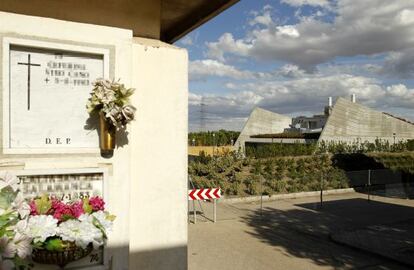Madrid suburb does not want to become a dead zone
Carabanchel is set to get second funeral home and crematorium Residents are concerned about effect of emissions from cremations


The Madrid suburb of Carabanchel does not want to be the capital's next home of the deceased. But that's the way the future seems to be shaping up, given that there will soon be four funerary facilities there.
Besides the cemetery - Madrid's second largest, after La Almudena - Carabanchel also has a regionally owned funeral home, with 42 wake rooms. It will soon add a crematorium, and a company named Servisa has started to build another private funeral home, conveniently located near the crematorium. This has led residents to suspect that there are economic interests behind the authorization to build the latter.
"They tell us that there's no danger, but nobody will sit down with us with the figures in their hand to assure us that the gas emissions from the crematorium will not be harmful," says Javier, 36, who lives with his wife and two children, aged six and one, in a Carabanchel residential development. Their home is close to Cementerio Sur, an enormous 70-hectare tract of land that was once on the outskirts, but has since been swallowed up by the city. But Javier had never worried about that - the cemetery was always there.
In a matter of weeks, however, Empresa Mixta de Servicios Funerarios, in which the Madrid government holds a 51-percent stake, will start operating a crematorium just a few hundred meters from his house. The facilities are complete, and all that is missing is the municipal operating license.
It is one thing to live next to a cemetery, says Javier, and quite another to be neighbors with a crematorium.
They tell us that there's no danger, but nobody will sit down with us with the figures in their hand"
Residents of Carabanchel have been fighting the crematorium for several years. In 2006, Empresa Mixta was planning to build two crematories within the existing funeral home, notes Pedro Casas, of the Carabanchel Alto Neighborhood Association. "We opposed the environmental impact study, and the regional government forced them to place the chimneys over 1,000 meters away, so they wouldn't be so close to living areas, schools and so on."
Later, the company considered building the crematories but piping the resulting gases underground to chimneys inside the cemetery. But the project changed again. Instead, it was decided to bring together crematories, chimneys and other rooms inside a brand new building.
"We are not aware that another environmental impact report was commissioned," says Casas. Also, the approved project talked about 200 square meters, not the more than 800 square meters that were eventually built.
A company spokeswoman said the crematorium meets all legal demands. However, official documents show that the building license was originally denied because the law prohibited new buildings within Cementerio Sur. Just six months later, without any changes to the law, the license was granted. The request talked about a building "extension" rather than a whole new building.
Residents collected 5,000 signatures against the crematorium.
"The fact that nobody will talk to us and that construction was conducted almost secretly makes us even more distrustful," says Javier, who is concerned about his kids breathing in the emissions. "Cremations emit heavy metals such as mercury."
Tu suscripción se está usando en otro dispositivo
¿Quieres añadir otro usuario a tu suscripción?
Si continúas leyendo en este dispositivo, no se podrá leer en el otro.
FlechaTu suscripción se está usando en otro dispositivo y solo puedes acceder a EL PAÍS desde un dispositivo a la vez.
Si quieres compartir tu cuenta, cambia tu suscripción a la modalidad Premium, así podrás añadir otro usuario. Cada uno accederá con su propia cuenta de email, lo que os permitirá personalizar vuestra experiencia en EL PAÍS.
¿Tienes una suscripción de empresa? Accede aquí para contratar más cuentas.
En el caso de no saber quién está usando tu cuenta, te recomendamos cambiar tu contraseña aquí.
Si decides continuar compartiendo tu cuenta, este mensaje se mostrará en tu dispositivo y en el de la otra persona que está usando tu cuenta de forma indefinida, afectando a tu experiencia de lectura. Puedes consultar aquí los términos y condiciones de la suscripción digital.
Últimas noticias
Science seeks keys to human longevity in the genetic mixing of Brazilian supercentenarians
Luisa Neubauer, climate change activist: ‘Ecology shouldn’t be a punitive force, but a joyful and liberating one’
Trump followed CIA recommendation to hand power to Delcy Rodríguez due to risk that Machado would not control the army
The Motherwell painting that Franco wanted to hide from view
Most viewed
- Alain Aspect, Nobel laureate in physics: ‘Einstein was so smart that he would have had to recognize quantum entanglement’
- Alvin Hellerstein, a 92-year-old judge appointed by Bill Clinton, to preside over Maduro’s trial in New York
- Cuba confirms death of 32 of its citizens in the US attack against Venezuela
- Gilles Lipovetsky: ‘If you want to live better and fall in love, take Prozac, don’t look to philosophy’
- Why oil has been at the center of Venezuela-US conflicts for decades








































